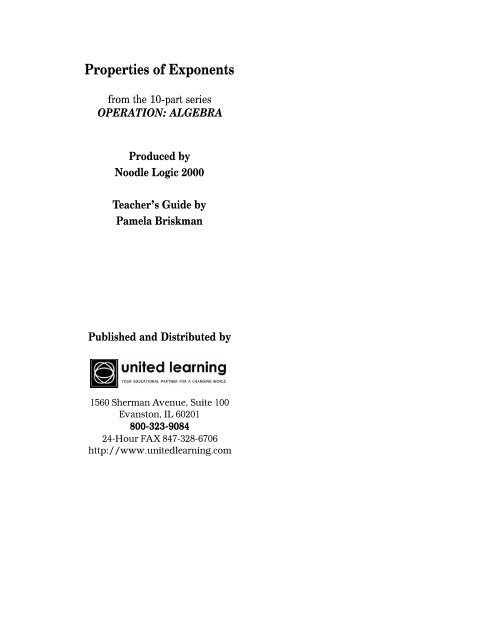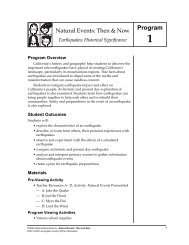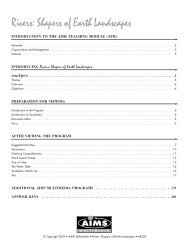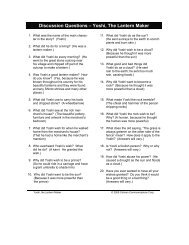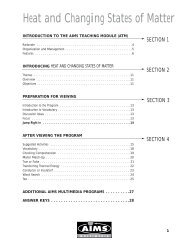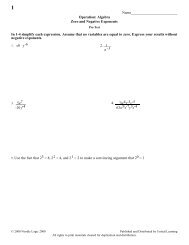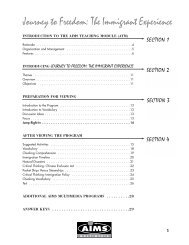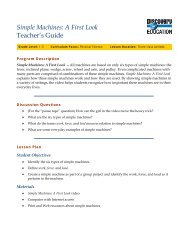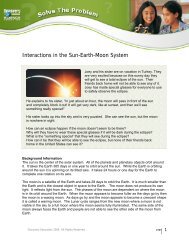Properties of Exponents - Discovery Education
Properties of Exponents - Discovery Education
Properties of Exponents - Discovery Education
You also want an ePaper? Increase the reach of your titles
YUMPU automatically turns print PDFs into web optimized ePapers that Google loves.
<strong>Properties</strong> <strong>of</strong> <strong>Exponents</strong>from the 10-part seriesOPERATION: ALGEBRAProduced byNoodle Logic 2000Teacher’s Guide byPamela BriskmanPublished and Distributed by1560 Sherman Avenue, Suite 100Evanston, IL 60201800-323-908424-Hour FAX 847-328-6706http://www.unitedlearning.com
This video is the exclusive property <strong>of</strong> the copyright holder.Copying, transmitting, or reproducing in any form, or by anymeans, without prior written permission from the copyright holderis prohibited (Title 17, U.S. Code Sections 501 and 506).© 2000 Noodle Logic 2000
Table <strong>of</strong> ContentsSeries Information . . . . . . . . . . . . . . . . . . . . . . . . . .1Program Three: <strong>Properties</strong> <strong>of</strong> <strong>Exponents</strong> . . . . . . . . . .5Objectives . . . . . . . . . . . . . . . . . . . . . . . . . . . . . . . . .5Summary . . . . . . . . . . . . . . . . . . . . . . . . . . . . . . . . .5Standards . . . . . . . . . . . . . . . . . . . . . . . . . . . . . . . . .6Assessment Tools . . . . . . . . . . . . . . . . . . . . . . . . . . .6Answer Key . . . . . . . . . . . . . . . . . . . . . . . . . . . . . . .6Episode at a Glance . . . . . . . . . . . . . . . . . . . . . . . . . .7Problem Details . . . . . . . . . . . . . . . . . . . . . . . . . . . . .9Script <strong>of</strong> Narration . . . . . . . . . . . . . . . . . . . . . . . . .13CCThis video is closed captioned.The purchase <strong>of</strong> this program entitles the user to the right to reproduceor duplicate, in whole or in part, this teacher’s guide and the blacklinemaster handouts that accompany it for the purpose <strong>of</strong> teaching in conjunctionwith this program, <strong>Properties</strong> <strong>of</strong> <strong>Exponents</strong>. This right isrestricted only for use with this program. Any reproduction or duplicationin whole or in part <strong>of</strong> this guide and the blackline master handoutsfor any purpose other than for use with this program is prohibited.
CLEARANCE NOTICEThis program is for instructional use. The cost <strong>of</strong> each programincludes public performance rights as long as noadmission charge is made. Public performance rights aredefined as viewing <strong>of</strong> a video in the course <strong>of</strong> face-to-faceteaching activities in a classroom, library, or similar settingdevoted to instruction.Closed Circuit Rights are included as a part <strong>of</strong> the pubic performancerights as long as closed-circuit transmission isrestricted to a single campus. For multiple locations, callyour United Learning representative.Television/Cable/Satellite Rights are available. Call yourUnited Learning representative for details.Duplication Rights are available if requested in large quantities.Call your United Learning representative for details.Quantity Discounts are available for large purchases. Callyour United Learning representative for information andpricing. Discounts, and some special services, are not applicableoutside the United States.Your suggestions and recommendations are welcome. Feelfree at any time to call United Learning at 1-800-323-9084.
"Operation: Algebra"Series InformationWhat is "Operation: Algebra?"The "Operation: Algebra" series is a supplementary resource for your AlgebraI program. "Operation: Algebra" consists <strong>of</strong> ten, 25-45 minute programs thatcan help you present/reinforce critical aspects <strong>of</strong> the Algebra I course withengaging stories, real world connections, presentation <strong>of</strong> various approaches, andclear delivery <strong>of</strong> content material. Full <strong>of</strong> real life examples, assessments, andoriginal curriculum on key, standards-based topics, "Operation: Algebra" is avaluable tool, that can be adapted to fit your classroom needs.What topics are included in the "Operation: Algebra" series ?The series includes programs for the following topics:• Solving Equations with Variables on Both Sides <strong>of</strong> the Equal Sign (ax + b =cx + d)• Transforming Formulas• <strong>Properties</strong> <strong>of</strong> <strong>Exponents</strong>• Zero and Negative <strong>Exponents</strong>• Introduction to Linear Relations• Using Tables to Graph Equations• Linear Equations: Ax + By = C• Slope <strong>of</strong> a Line• Linear Equations : y = mx + b• Introducing Linear SystemsWhy would I use this series?Depending on your needs, you may want to use this series:• as a way to ensure that your students are exposed to multiple perspectives onkey concepts that appear in the standards.• to provide students with real-world connections for the math they are learning(answering the question, "When will we ever have to use this?").• as a springboard to introduce a new concept.• to review or re-teach a concept with which students are struggling.• for a change <strong>of</strong> pace, or to engage students with a story or illustration.• for students who need reinforcement <strong>of</strong> certain concepts or a chance to re-watcha lesson at their own pace, or even at home.• as a resource to see the approach <strong>of</strong> another teacher and to get new ideas foryour own presentation.• when you have a substitute teacher and want to make sure that content is delivered.How can I use this series most effectively?The "Operation: Algebra" programs are designed so that they can be watchedstraight through, but students will surely get more out <strong>of</strong> each episode given1
more time to interact with and think about the material than the program can provideon its own. Don't be afraid to:Stop the program at critical points to:• check for student understanding,• give students an extra practice problem,• lead a discussion,• provide an alternate explanation or approach,• allow time for students to do a problem on their own before the tape presentsthe solution,• solve a problem as a class and use the tape to reinforce the steps you just didtogether.Skip around the program to select segments that are especially relevant foryour class.• The enclosed teacher notes will help you do this efficiently and effectively.Encourage students to ask questions.• Develop an organized system allowing students to stop the program when needed.• Have students write down questions as they watch.Ask students to take notes and do the practice problems themselves as theywatch.• "Note-worthy" information usually appears on a red-screen for easy identification.• many practice problems appear on a blue background.Adapt the system so that it best meets your and your students' needs.What is the Lesson Information and what does it include?The Lesson Information on the following pages are designed to help you quicklyskim for the information that you are looking for as well as to provide detailedinformation about the math content in each episode. They also can be used "onthe fly" to help you navigate the program to deliver just the content that you arelooking for or to present the problems from the episode to your students as needed.The Lesson Information for each episode contains the following:Lesson Title:Allows you to quickly select the tape most relevant to the subject you are teaching.Running time:Lets you know how long the program runs from start to finish, including theassessment problems at the end.2
Use this to help you plan how you want to use the programs. Will you run fromstart to finish without stopping? Will you need two class periods to allow time towatch the entire program and stop for interactions? Will you want to select onlycertain segments <strong>of</strong> the program so that it fits it into your schedule?Objectives:Statement <strong>of</strong> the educational goals <strong>of</strong> the lesson.Summary:The summary tells you just what to expect from each program. It "previews" thespecific content and context for the lesson, <strong>of</strong>ten listing the actual mathematicsexamples used in the tape as well as the pedagogical approaches employed.Use the summary as a guide to help you select the parts <strong>of</strong> a program that aremost relevant to you and your students. With a quick read for the complexity <strong>of</strong>the problems and the approach to solving them, the summary can also help youto decide if you will need to pre-teach or review any concepts to help your studentsget the most out <strong>of</strong> the program.Standards:A reference to what content standards the program addresses. Program content islinked to the state <strong>of</strong> California Algebra Standards 2000. Use these standardsalignments as reference points to connect the content <strong>of</strong> the program with yourown local standards. Please note that the standards <strong>of</strong>ten cover a broad contentarea, and that the program, in most cases, addresses only a portion <strong>of</strong> the standard.Notes:In some cases, the episode includes extra pieces <strong>of</strong> information to give you specificideas, advice, or background about certain portions <strong>of</strong> the program. Theseappear in the notes section.Episode at a glance:A minute-by-minute timeline outlining the critical problems, notes, and solutionspresented in the episode.Refer to this section as you watch to keep track <strong>of</strong> where you are in the episode.Use the time stamps to gauge the length <strong>of</strong> a particular segment or to skip aroundto relevant parts <strong>of</strong> the program. Preview the assessment questions.Problem Details:This section provides a chronological listing <strong>of</strong> all <strong>of</strong> the math problems in anepisode with show-your-work style-solutions. It also includes the factual backgroundbehind many <strong>of</strong> the real-world problems as well as selected pedagogicalreferences.3
This reference gives you some insight as to how the problems are presented inthe program. If you choose to stop the program and have students solve the problemsas a class or on their own, use the problem details so you won't have to constantlyrefer to the screen just to write the problem on the board. The problemdetails can also help guide you in your presentation.If you want to be sure to present a problem in the same way as the program doesso that students will find reinforcement and ease in following along when theywatch the program, the problem details can help you to do this. Alternatively, youcan use the problem details to guide students to solve the problem in a differentway than the tape does to provide alternate approaches to the same problem.Assessment Tools:Pre-TestThis Blackline Master will enable you to gauge student comprehension <strong>of</strong> thesubject prior to their participation in the lesson surrounding the program. ThePre-Test Blackline Master correlates directly with the objectives presented in theepisode and with the assessment questions that follow the lesson and appear onthe assessment master. Comparing results between the pre- and post-assessmentcan provide you with some data about student achievement and comprehension.Program Assessment:If you would like to use the on-screen assessment questions, but want students tohave a hard copy to work on or to take home, a Blackline Master Assessment isprovided for your convenience.Answer Key:To assist you with grading papers, answers are provided for both the Pre-Test andProgram Assessment.Instructional Notes:While the Lesson Information can help you prepare to use the "Operation:Algebra" programs and serve as a great resource for using the programs " thereis no substitute for watching the program yourself before you present it to yourclass. First-hand exposure to the content will enable you to brainstorm your ownideas to use the program to its utmost potential as it applies to your teaching styleand to the needs <strong>of</strong> your students.“Operation: Algebra”4
<strong>Properties</strong> <strong>of</strong> <strong>Exponents</strong>Running time: 40:55Objectives:1. Learn to use and apply the properties <strong>of</strong> exponents involving products <strong>of</strong> powers,quotients <strong>of</strong> power and power <strong>of</strong> powers.2. Use and simplify expressions with powers in real life situations.Summary:This episode deals with the first three laws <strong>of</strong> exponents and nods at the 4th law<strong>of</strong> exponents. Leveraging the great quantities used in astronomy, the episode asksthree questions that require manipulation <strong>of</strong> exponents to answer: 1) How faraway is the Andromeda Galaxy in miles? 2) How much energy does the sun produceeach second? and 3) If the sun continues to produce energy at this rate,when will it run out <strong>of</strong> energy? The first half <strong>of</strong> the program deals with the firstquestion and the first law <strong>of</strong> exponents-the Product <strong>of</strong> Powers Property. The secondhalf <strong>of</strong> the program deals with the second two questions and the second andthird laws <strong>of</strong> exponents-the Quotient <strong>of</strong> Powers Property and the Power <strong>of</strong> aPower Property. The tape can be watched in two parts or all together.Part 1: This part begins by addressing the concept <strong>of</strong> a light year and the distancesbetween the Earth and various celestial objects. We find that theAndromeda galaxy is 2.9 million light years from Earth, but how far is that inmiles? Using standard numbers we can find an answer with a lot <strong>of</strong> zeros. Withscientific notation, we get the expression (5.9 • 10 12 ) (2.9 • 10 6 ). But to simplifythe powers <strong>of</strong> ten, we need to learn the Product <strong>of</strong> Powers Property. By usingrepeated multiplication, we find that to multiply powers with the same base, youadd the exponents. After several practice problems, we address the common error<strong>of</strong> adding exponents when multiplying powers with different bases in a humoroussketch featuring the Algebraleins. With out new skills in mind, we revisit theopening question about the distance to Andromeda, find that by applying the firstlaw <strong>of</strong> exponents we arrive at the same answer in a much more efficient way.Part 2: This part begins with a discussion with an astronomer who explains thatmass is converted into energy in accordance with Einstein's famous equatione=mc 2 when the sun converts hydrogen atoms into helium. To find how muchenergy (e) the sun creates each second, we can use Einstein's equation and multiplythe mass lost each second (m) by the speed <strong>of</strong> light (c) squared, e = (5 •10 12 ) (3 • 10 10 )2. And to find out how long the sun can produce energy at thisrate, we divide the sun's total mass by the amount <strong>of</strong> grams that are lost each secondwhen hydrogen is turned into helium, (2.4 • 10 32 )/(5 • 10 12 ). To simplifythese expressions, we need to learn the Quotient <strong>of</strong> Powers Property and thePower <strong>of</strong> Powers Property. Exploring the meaning <strong>of</strong> exponents as repeated multiplication,we conclude that to divide powers with the same base, you subtractthe exponents and to raise a power to a power you multiply the exponents. We5
practice each <strong>of</strong> the laws with examples before applying these new skills toanswer the questions about the sun.Standards:This episode addresses California Algebra Standard 2: Students understand anduse such operations as taking the opposite, reciprocal, raising to a power, and takinga root. This includes the understanding and use <strong>of</strong> the rules <strong>of</strong> exponents.Notes:This episode contains a lot <strong>of</strong> content. It may be best used in 2 parts. Use the first18-or-so minutes to accompany lessons on the 1st law <strong>of</strong> exponents-the Product<strong>of</strong> Powers Property and the last 20-or-so minutes with lessons on the 2nd and 3rdlaws <strong>of</strong> exponents-the Quotient <strong>of</strong> Powers Property and the Power <strong>of</strong> a Powerproperty. There is a natural break between the two halves, each leading <strong>of</strong>f witha different real world problem.Assessment Tools:Pre-TestBlackline Master 1, Pre-Test, will enable you to gauge student comprehension<strong>of</strong> the subject prior to their participation in the lesson surrounding the program.The Blackline Master 1, Pre-Test, correlates directly with the objectives presentedin the episode and with the assessment questions that follow the lesson ,which appear on Blackline Master 2, Program Assessment. Comparing results<strong>of</strong> the Pre-Test and Program Assessment can provide you with some data aboutstudent achievement and comprehension.Program AssessmentIf you would like to use the on-screen assessment questions, but want students tohave a hard copy to work on or to take home, a Blackline Master 2, ProgramAssessment is provided for your convenience.“Operation: Algebra” <strong>Properties</strong> <strong>of</strong> <strong>Exponents</strong>Answer KeyBlackline Master 1, Pre-Test1. x 322. 3 123. c 54. » .62 • 10 2» 6.2 • 10 1» 62 kilograms <strong>of</strong> food per person5. 3 • 10 16 cubic meters <strong>of</strong> iceBlackline Master 2, Program Assessment1. w 54 6
2. 5 113. e 44. » 1.7 • 10 2 babies per minute5. 21 • 10 12 red blood cellsEpisode at a Glance:0:00 Introduction and Objectives4:40 Set up real-world problem.Question about astronomy. How far away is the galaxy Andromeda in miles?7:50 Explore real-world problem mathematics.Find distance to Andromeda using standard numbers.Write problem using scientific notation: (5.9 • 10 12 ) (2.9 • 10 6 )9:47 Example 1:Multiply powers with the same base: x 4 • x 3 .11:37 Notes:Product <strong>of</strong> Powers Property (1st law <strong>of</strong> exponents)For any a and b, then x a • x b = x a + bTo multiply powers with the same base, add the exponents-the base stays thesame.12:03 Try this:4 2 • 4 913:29 Algebraliens skit:Investigate why 3 2 •2 3 ◊ 6 2+3 ◊ 6 5 .17:21 Revisit opening question.Apply the 1st law <strong>of</strong> exponents to simplify (5.9 • 10 12 ) (2.9 • 10 6 ), finding thedistance to Andromeda in miles.18:53----------------stop tape here to cover just 1st law <strong>of</strong> exponents---------------18:57 Set up real world problem.Questions about astronomy:1) How much energy does the sun create per second?2) Will the sun ever run out <strong>of</strong> energy?21:50 Explore real-world problem mathematics.7
To solve question 1, simplify the expression (5 • 10 12 ) (3 • 10 10 ) 2 .To solve question 2, simplify the expression (2.4 • 10 32 )/(5 • 10 12 ).23:17 Example 2:Divide powers with the same base: x 8 /x 5 .25:25 Notes:Quotient <strong>of</strong> Powers Property (2nd law <strong>of</strong> exponents)For any a and b, and x ◊ 0, then x a / x b = x a - b .To divide powers with the same base, subtract the exponents _ the base remainsthe same.25:55 Try this:6 6 / 6 427:33 Example 3:Find the power <strong>of</strong> a power: (x 4 ) 5 .29:23 Notes:Power <strong>of</strong> a Power Property (3rd law <strong>of</strong> exponents)For any a and b, then (x a ) b = x a • b .To raise a power to a power, multiply the exponents-the base remains the same.29:45 Try this:(15 7 ) 431:30 Revisit real world problems.Apply the 3rd and 4th laws <strong>of</strong> exponents to simplify (5 • 10 12 ) (3 • 10 10 ) 2 , t<strong>of</strong>ind out how much energy the sun creates each second.Apply the 2nd law <strong>of</strong> exponents to simplify (2.4 • 10 32 )/(5 • 10 12 ), to find outhow long the sun can continue to produce energy at the given rate.36:56 Restatement <strong>of</strong> objectives:38:45 Assessment:In 1-3, simplify each expression using one <strong>of</strong> the laws <strong>of</strong> exponents. Then, userepeated multiplication to show why the law works.1. (w 6 ) 92. 5 2 • 5 4 • 5 53. e 7 / e 34. Each year, about 90 million or 9 • 10 7 babies are born in the world. A year containsapproximately 530,000 or 5.3 • 10 5 minutes. Use one <strong>of</strong> the laws <strong>of</strong> exponentsto figure out how many babies are born each minute.5. Red blood cells carry oxygen around the body.A 130 pound person has about8
4.2 • 10 6 microliters <strong>of</strong> blood. Each microliter <strong>of</strong> blood contains 5 • 10 6 redblood cells. Use one <strong>of</strong> the laws <strong>of</strong> exponents to figure out how many red bloodcells a 130 pound person has.Problem Details:Real world problem set up _ distances in astronomy:Distance from the Earth to the Moon _ 239,000 miles _ 1.5 light-secondsDistance from the Earth to the Sun _ 93,000,000, miles _ 8 light-minutesDistance from the Earth to the Andromeda Galaxy _ ? Miles _ 2,900,000 light-yearsHow far is it to the Andreomeda Galaxy in miles?Determine the distance using standard notation:light travels 5,900,000,000,000 miles per year.5,900,000,000,000 miles x 2,900,000 years =17,110,000,000,000,000,000 milesyears_ Use scientific notation to make to make the calculation more manageable:(5.9 x 10 12 )(2.9 x 10 6 )=???To simplify the problem in this form, we need to learn how to multiply the pow -ers <strong>of</strong> 10. We need to multiply powers with the same base-that's the 1 st Law <strong>of</strong><strong>Exponents</strong>.Example 1 _ multiplying powers with the same basex 3 • x 4• Original problem.x 4 x 3 • Rewrite powers in expanded form.x • x • x • x • x • x • xx 7• Multiply powers together.• Rewrite as a power.It follows that:x 3 • x 4 = x 3 + 4 = x 7This is an example <strong>of</strong> the 1 st law <strong>of</strong> <strong>Exponents</strong>-The Power <strong>of</strong> Powers PropertyTry This _First use the Power <strong>of</strong> Powers Property then prove using repeated multiplication:4 2 • 4 9 • Original problem.4 2 + 9 • Apply the Power <strong>of</strong> Powers Property.4 11 • Add the exponents.9
Algebraliens skit _Illustrate why 3 2 •2 3 6 2+3 6 5Show expanded form72S t ress that powers must have the same base to apply the product <strong>of</strong> powers pro p e rt y.Revisit real-world problem, distance to AndromedaNow we can simplify using 1 st law <strong>of</strong> exponents.(5.9 x 10 12 )(2.9 x 10 6 ) • Standing problem.(5.9)(2.9)(10 12 )(10 6 ) • Commutative property <strong>of</strong> equality allowsus to rearrange the factors in the problem.17.11(10 12 )(10 6 ) • Multiply decimal factors.17.11 x 10 18 • Apply 1st law <strong>of</strong> exponents-product <strong>of</strong>powers property.The 1 st law <strong>of</strong> exponents allows us to arrive at the same answer as before in amuch more efficient way. Either way you figure, the distance between the Earthand the Andromeda Galaxy is about 17 quintillion, 110 quadrillion miles.Real-world problem set up: Facts about the Sun:The Sun is a hot ball <strong>of</strong> hydrogen and helium that works like a giant nuclear reactor.Near the center <strong>of</strong> the Sun, where there is enormous pressure and temperatures,the Sun fuses its hydrogen atoms into helium atoms. It takes four hydrogenatoms to make one helium atom, but one helium is smaller in mass than thefour hydrogen atoms that created it. The extra mass is converted into energy andit is that energy that makes the Sun hot and bright.Mass is converted into energy according to Einstein's famous equation, E=mc 2 .By using E=mc 2 , you can figure out how much energy is released when massgets turned into energy, The energy created is equal to the mass times the speed<strong>of</strong> light squared.Here are the facts that will help us determine how much mass is lost when thesun turns hydrogen into helium:• The Sun turns about 600 trillion grams <strong>of</strong> hydrogen into helium per second withabout five trillion grams vanishing into pure energy.• The speed <strong>of</strong> light is 186,000 miles per hour, or 30 billion centimeters per second.10
So,E=mc 2• Given equation.E=(5x1012)c 2• Substitute the mass that vanishes per secondfor m.E=(5x10 12 )(3x10 10 ) 2 • Substitute the speed <strong>of</strong> light (cm/sec) for c.To simplify this problem, we need to know how to raise a power to a power-that'sthe 3 rd Law <strong>of</strong> <strong>Exponents</strong>.So the sun loses five trillion grams <strong>of</strong> itself (that's about five million tons) eachsecond when it converts mass to energy. How long can it go on like this beforeit burns itself out?To figure out the Sun's total lifetime, we can divide the total mass <strong>of</strong> the Sun bythe rate it is converting mass to energy.• The sun contains about 240 million trillion grams <strong>of</strong> hydrogen gas as availablefuel.So,available mass• Suggested process.mass lost each second2.4 x 10 32 • Substitute actual values.5 x 10 12To simplify this problem, we need to know how to divide the powers <strong>of</strong> 10. Weneed to divide powers with the same base _ that's the 2 nd Law <strong>of</strong> <strong>Exponents</strong>.Example 2 _ dividing powers with the same basex 8• Original problem.x 5x • x • x • x • x • x • x • x • Rewrite powers in expanded form.x • x • x • x • xx • x • x • x • x • x • x • x • Divide out common factors in numeratorx • x • x • x • xand denominator.x 3• Rewrite as a power.It follows that:x 8 = x 8 - 5 = x 3x5This is an example <strong>of</strong> the 2 nd law <strong>of</strong> <strong>Exponents</strong> _ The Quotient <strong>of</strong> Powers Property11
Try this _First use the Quotient <strong>of</strong> Powers Pro p e rt y, then prove using repeated multiplication.6 6 • Original problem.6 46 6 - 4 • Apply the Quotient <strong>of</strong> Powers Property.6 2 = (36) • Subtract the exponents.6 6 6 • 6 • 6 • 6 • 6 • 66 4 = 6•6•6•6 =6 2Example 3-raising a power to a power(x4) 5• Original problem.x 4 • x 4 • x 4 • x 4 • x 4• Rewrite powers in expanded form.x 4 + 4 + 4 + 4 + 4• Apply the 1st Law <strong>of</strong> <strong>Exponents</strong>. (product<strong>of</strong> powers)x 4 • 5• Write repeated addition as multiplication.x 20• Multiply the exponents.It follows that:(x 4 ) 5 = x 4 • 5 = x 20This is an example <strong>of</strong> the 3 rd law <strong>of</strong> <strong>Exponents</strong>-The Power <strong>of</strong> a Power Property.Try This _First use the Power <strong>of</strong> a Power Property then prove using repeated multiplication(15 7 ) 4 • Original problem.15 7 • 4 • Apply the Power <strong>of</strong> a Power Property.15 28 • Multiply the exponents.(15 7 ) 4 = 15 7 • 15 7 • 15 7 • 15 7 = 15 7 + 7 + 7 + 7 = 15 7 • 4 = 15 28Revisit real-world pro b l e m _ how much energy does the sun create each second?Now we can simplify using 3rd law <strong>of</strong> exponents. (We'll also hint at the 4th Law)E=mc 2• Einstein's equation.E=(5x10 12 )(3x10 10 ) 2• Standing problem.E=(5x10 12 )(3x10 10 )(3x10 10 ) • Apply the exponent (2).E=(5x10 12 )(3)(3)(10 10 )(10 10 ) • Use commutative property to rearrangefactors.E=( 5 x 10 12 ) (3) 2 (10 10 ) 2 • Rewrite with exponents. Note: By applying the exponent, we see that the exponent,(2), on the outside <strong>of</strong> the parenthesis effectivelygets distributed to each factor on theinside <strong>of</strong> the parenthesis. This is the 4th Law<strong>of</strong> <strong>Exponents</strong>.12
x 9x 3where you have to divide two powers with the same base and you'll know howto deal with problems that look like this:(x 4 ) 7where you must find a power <strong>of</strong> a power.Knowing the three laws <strong>of</strong> exponents will enable you to simplify all kinds <strong>of</strong>algebraic expressions. These skills will also be useful in real life situationswhere you have to deal with scientific notation, figure out exponential growth ordecay, or evaluate other formulas involving exponents.We have two main objectives for today. They are:1) To learn to use and apply the properties <strong>of</strong> exponents involving products <strong>of</strong>powers, quotients <strong>of</strong> powers and powers <strong>of</strong> powers, and to2) Use and simplify expressions with powers in real life situations.The properties <strong>of</strong> exponents that we'll cover today will enable you to manipulateexponents much more efficiently than you could by just using repeated multiplication.People need techniques to use with exponents when they're dealing with thingsthat are very, very small or very, very large. In fact, people who are interested inouter space use exponents all the time to help them manage the very large distancesbetween celestial objects.The objects that we see in the sky are all very far away, especially when comparedto the distances that were normally used on earth. For example, the distanceacross the United States is about 3,000 miles. The distance from the earthto the moon is 239,000 miles. The sun is about 93 million miles from the earth.The most distant object in the universe that can be seen without a telescope is thegreat spiral galaxy in the constellation Andromeda. It's 2.9 million light-yearsfrom the earth. How far is that? Let's go into the planetarium to find out.Planetariums are great places to go to learn about astronomy. They provideinstructive exhibits, wonderful sky shows, night time sky watching sessions andmany have excellent shops where you can check out all the things you need tolearn more about what you see in the sky. Let's take a look through the telescope.Here is a picture <strong>of</strong> the Andromeda galaxy as seen through a very powerful telescope.To the naked eye though, Andromeda is just another fuzzy patch thatappears in the northern autumn evening sky.14
Actually, it's amazing that you can see Andromeda at all, because it's 2,900,000light-years away from the earth. This means that it takes light about 2,900,000years to travel from Andromeda to our planet.Just to impress upon you exactly how far that is, let's talk about light-years for amoment.A light-year is equal to about 5.9 trillion miles, which is the distance that lighttravels over the course <strong>of</strong> a year as it journeys through space at 186,000 miles persecond.So, how can we relate to that? Well, the distance from the earth to the moon is239,000 miles. Light can travel that distance in about 1⁄ seconds. So, if youcould shine a flashlight at the moon, the light from your flashlight would hit thesurface <strong>of</strong> the moon 1⁄ seconds later. Therefore, we say that the moon is 1⁄ lightsecondsaway from the earth.The earth revolves around the sun at a distance <strong>of</strong> 93 million miles. Light comingfrom the surface <strong>of</strong> the sun takes about 8 minutes to reach the earth.Therefore, the earth is 8 lightminutes from the sun.Even at this remarkable speed, light still takes almost 3 million years to reach usfrom Andromeda. So, the Andromeda that we see when we look at the sky today,is like an old photograph taken <strong>of</strong> the great galaxy 2.9 million years ago. That'slong before the earliest humans walked the face <strong>of</strong> the earth. And, if Andromedadisappeared today by some mysterious means, we on earth wouldn't know it foralmost three million years.You still want to know how many miles Andromeda is from the earth, don't you?Okay, let's figure it out. Light travels 5,900,000,000,000 miles in a year. AndAndromeda is 2,900,000 light-years away.Multiplying the distance that light travels in a year by the number <strong>of</strong> light-yearsAndromeda is from the earth, will tell us how far away Andromeda is in miles.So, we get 5.9 trillion x 2.9 million. That's a lot <strong>of</strong> zero's to multiply, but doingthe math, we get, how do we even say that? Let's see, that's 17 quintillion, 110quadrillion miles.So, when we say that Andromeda is 2.9 million light-years from the earth, that'sequal to this many miles.The numbers in this calculation are so large that they're hard to work with in standarddecimal form. We can make the calculations more manageable by writingthe factors with scientific notations. Then, the problem looks like this:(5.9 · 10 12 )(2.9·10 6 )15
It still says 5.9 trillion times 2.9 million, but to be able to multiply the numbersin this form, we need to know what to do with the powers <strong>of</strong> 10.That means we'll need to know how to multiply powers with the same base. Andthat's the first thing we're going to learn to do today.Let's go to the math lab.Let's start with a few definitions. Any expression like this one, x n , where youhave a number or variable raised to an exponent is called a power.A power has two parts, a base and an exponent. The exponent tells you howmany times the base is to be used as a factor. So, in the power x 4 , x is to be usedas a factor 4 times. So, x 4 = x · x · x · x. That much you should know already,but how do you make calculations when you multiply powers together? Let'stake a look.Say we have the problem x 4 · x 3 . Your knowledge <strong>of</strong> exponents representingrepeated multiplication might lead you through the following steps:x 4 = x · x · x · x and x 3 = x · x · x. When we multiply both powers together, weget x · x · x · x · x · x · x. All together, that's 7 xs, or we can just say x 7 .So, the solution to x 4 · x 3 is x 7 power.From this example, you may have already seen a short cut that will enable youto quickly multiply powers without using repeated multiplication. When wemultiplied x 4 by x 3 , we combined 4 xs with 3 xs to get 7 xs. Since both powershave x as a base, when we multiply them together, we can just add the exponents.So, the more efficient way to do this problem would be to say: x to the 4 th timesx to the 3 rd = x to the 4 + 3, or x to the 7 th .This is the first law <strong>of</strong> exponents, or the product <strong>of</strong> powers property. It says forany a and b, then x a · x b = x a + b and the base remains the same. In words, thislaw says that to multiply powers with the same base, you add the exponents andthe base remains the same. Make sense? Here, try this one. First use the product<strong>of</strong> powers property and then, show how it works using repeated multiplication.Let's see how you did. Since this problem involves multiplying two powers withthe same base, we can find the product by adding the exponents. 4 2 · 4 9 is 4 2 +9 , or 4 11 . This works because 4 2 gives us two 4s and 4 9 gives us nine 4s.Multiplying the powers together gives us 4 used as a factor 11 times, or 4 11 .So, that's the first law <strong>of</strong> exponents, the product <strong>of</strong> powers property. It tells usthat whenever you multiply powers with the same base, the product will be apower <strong>of</strong> that base, with an exponent equal to the sum <strong>of</strong> the exponents <strong>of</strong> thefactors. In other words, when you multiply powers with the same base, add theexponents.16
Let's see how this works.We now join the Algebralians on their universal quest for math. Today, we findthem doing maintenance on their space ship.Javthak, Javthak, yes, you Javthak, who else could I be talking to?Oh, hi Leader. You don't sound very happy.I am not, Javthak. I've been looking over some data from your recent maintenancework and I'm sorry to say, but I'm putting you on probation until furthernotice.Probation, what did I do?In your last assignment, you violated the first law <strong>of</strong> exponents. Please correctyour mistakes immediately. I'll be watching you closely, out.What did I do? What do you mean? Yikes. Let's see, where's that work I didlast week?Oh, here it is. Hmmmm, it still looks okay to me. I better get some help, let mecall my friends. Hey guys.Hey, what's going on? What's up?Hi guys, I'm so glad you came. I broke the first law <strong>of</strong> exponents and the leaderis very angry with me.Uh oh.Will you look at this problem and help me correct my mistake?Sure, no problem.Oh yeah, <strong>of</strong> course, we love Algebra problems.Yeah, let's do it.Well, here's what I did.Oh, it looks like you broke the first law <strong>of</strong> exponents. That one says, that whenyou multiply powers with the same base, you add exponents.Um Hm.Yeah, this looks like it could be fun Javthak but, the powers must have the samebase.17
Yeah, everyone knows that.But look at your work, one has the power base <strong>of</strong> 3 and _ and the other has thebase <strong>of</strong> 2.You can't use the first law <strong>of</strong> exponents here, because the powers have differentbases.Oh, I see my mistake now. I multiplied the bases 3 and 2 to get 6. Then, I addedthe exponents 2 and 3 to get 5. That's how I got the wrong answer, 6 5 . I did forgetthat the product <strong>of</strong> powers property can only be used when you have powerswith the same base.Yeah, when the bases are different, you have to multiply things out the long way.Yeah, oh I can do that, multiplying is my favorite part.Um, sure, cool.Yeah, okay, yeah okay.Okay, okay, check it out. 3 2 is 3 · 3, okay? And 2 3 is 2 · 2 · 2.I get it, I get it!See, then you just multiply all the factors together one at a time.3 · 3 is 9 · 2 is 18 · 2 is 36 · 2 is 72.So your answer should be 72.Oh, wow, I was really <strong>of</strong>f there. I see why the leader was so angry. Now that Iremember that the bases have to be the same if I want to add the exponents, Iwon't mess up again. Thanks so much guys.No problem, that was a great time.Yeah it's cool.We love it.And there we'll leave the Algebralians remembering that the first law <strong>of</strong> exponents,the product <strong>of</strong> powers property, says that to multiply two powers with thesame base, you add the exponents.Tune in next time, when the Algebralians say…Oh, oh we're goin' the wrong way.18
Now that we've learned the product <strong>of</strong> powers property, let's go back to theAndromeda galaxy and find its distance away in miles using scientific notation.We couldn't solve this problem in this form before, because we didn't know whatto do with the powers <strong>of</strong> 10.Now that we know the first law <strong>of</strong> exponents, this shouldn't be a problem. Whatwe really have here is four factors being multiplied together. 5.9 · 10 12 · 2.9 ·10 6 . The commutative property tells us that the order we use to multiply a series<strong>of</strong> numbers doesn't matter. So, we can rearrange the four numbers, writing theregular decimals first and the powers <strong>of</strong> 10 second. There we go, now we canmultiply the decimals. 5.9 · 2.9 is 17.11 and multiplying 10 12 · 10 6 , we add theexponents 12 and 6 to get 10 18 . The word for 10 18 is a quintillion. So thisanswer 17.11 · 10 18 is the same answer that we got before. It tells us that whenyou see Andromeda with your naked eye, you're seeing a galaxy that's 2.9 millionlight-years, or 17.11 quintillion miles from the earth. I really think that'samazing. Let's check back at the planetarium and see what else we can learn.So many people are attracted to astronomy by the beauty <strong>of</strong> a starry night and amoonlit sky. You need nothing more than a sunny day to experience an astronomicalobject firsthand.That's right, the sun is the nearest star to earth. It's so commonplace in our livesthat we don't stop to think about it that much. But, if you do take some time tothink about the sun, there's a lot to wonder about.And there is, certainly some <strong>of</strong> the questions that we get about the sun are, howdoes the sun produce all <strong>of</strong> this energy? What is the source? And, will it everrun out <strong>of</strong> energy?Well, what do you tell them?Well, first I tell them that the sun is a giant ball <strong>of</strong> very, very hot gas and this gasis made mostly <strong>of</strong> hydrogen and helium. Now, down deep in the heart <strong>of</strong> the sun,in its core, the sun is extremely hot and down there the sun is taking the hydrogenand squeezing it very hard until it becomes helium.Okay.And in the formation <strong>of</strong> helium, there's an enormous amount <strong>of</strong> energy that'sreleased. It takes 4 hydrogen atoms to create 1 helium atom. But, in the strangeness<strong>of</strong> nature, the-the total mass <strong>of</strong> 4 hydrogen atoms does not equal the mass<strong>of</strong> a single helium atom.What happens to the extra mass?The tiny bit <strong>of</strong> mass that doesn't wind up in the helium creates an enormousamount <strong>of</strong> energy. The first person to realize the relationship between mass andenergy was a fellow by the name <strong>of</strong> Albert Einstein.19
Hi, I'm Albert Einstein. It followed from the special theory <strong>of</strong> relativity, thatmath and energy are both but different manifestations <strong>of</strong> the same thing. A somewhatunfamiliar conception for the average mind. Furthermore, the equation Eis equal to MC 2 in which energy is put equal to math, multiplied by the square<strong>of</strong> the velocity <strong>of</strong> light. So, that very small amounts <strong>of</strong> mass may be convertedinto a very large amount <strong>of</strong> energy and vice versa.He presented his relationship here in one <strong>of</strong> the world's greatest equations onnature. E, energy = M, mass times the speed <strong>of</strong> light, C squared.So how much mass is law when hydrogen is turned into helium?Well, the sun takes about 600 trillion grams <strong>of</strong> hydrogen and converts it into 595trillion grams <strong>of</strong> helium, with the five extra trillion grams going straight up intoenergy.Wow, the numbers that you deal with in astronomy are overwhelming, but I thinkI've got it. To find out how much energy the sun creates per second, we can useEinstein's equation, E = MC 2 . M is the mass that gets changed into energy, orthe 5 trillion grams that are lost each second when hydrogen is changed into heliumand C is the speed <strong>of</strong> light, or 186,000 miles per second, or 30 billion centimetersper second.The sun loses five trillion grams per second. How long can it go on like this?Won't it burn itself out?Take the sun's total mass, which is around 240 million, trillion, trillion grams, therate that it's converting energy over its total lifetime, you can get the actual lifetime<strong>of</strong> the sun's burning.So, that's 240 million, trillion, trillion grams <strong>of</strong> fuel divided by five trillion gramsthat the sun loses each second. Okay, we've got two problems to solve. One willtell us how much energy the sun creates each second and the other will tell ushow long the sun can last burning itself up at the current rate.Not too bad for a day <strong>of</strong> math and astronomy, but we don't have all the skills weneed to solve these problems yet. To solve this problem, we still need to learnhow to divide powers with the same base. That's the second law <strong>of</strong> exponents.And, to solve this problem, we'll have to learn what to do when you have a powerraised to a power. That's the third law <strong>of</strong> exponents.So, we've got two more laws to learn. Let's go.First, let's talk about dividing powers with the same base.Say we have the expression, x to the 8 th divided by x to the 5 th . In this problem,we're dividing two powers with the same base. We can figure out what todo with expressions like this by using repeated multiplication.20
So, x 8 = x · x · x · x · x · x · x · x, eight xs and x 5 = x · x · x · x · x, five xs. Whenwe divide, we can cancel common factors in the numerator and denominator,because they'll divide out to equal 1.Since x over x = 1. Five pairs <strong>of</strong> xs divide out, leaving us with x · x · x, or x 3power. So, the quotient <strong>of</strong> x 8 divided by x 5 is x 3 .From this example, you may have seen another short cut for dealing with exponents.This one will help you to quickly divide exponents with the same base.When we divided x 8 by x 5 , we could eliminate the common factors with division,because they both have x as a base.We found that five xs in the denominator cancelled out five <strong>of</strong> the xs in thenumerator, leaving us with a difference <strong>of</strong> three xs, or x 3 . This shows us thatwhen we divide powers with the same base, we can just subtract the exponents.A more efficient way to do this problem would be to say; x to the 8 th divided byx to the 5 th = x to the 8 - 5, or x to the 3 rd . This is the second law <strong>of</strong> exponents,or the quotient <strong>of</strong> powers property. It says, for any a and b and x does not equalzero, thenx ax b = x a-b .In words, this law says that to divide powers with the same base, you subtract theexponents and the base remains the same. Make sense? Here, try one on yourown.First use the quotient <strong>of</strong> powers property and then show why it works by showingrepeated multiplication.All right, how did you do? Since this problem involves dividing two powerswith the same base, we can find the quotient by subtracting the exponents.6 66 4 is 6 6-4 , or 6 2 .This works because 6 6 gives us six 6s in the numerator and 6 4 gives us four 6sin the denominator. When we divide, 4 pairs <strong>of</strong> 6s divide out, leaving us with 6X 6, or 6 2 .So, that's the second law <strong>of</strong> exponents, the quotient <strong>of</strong> powers property.Whenever you divide powers with the same base, the quotient will be a power <strong>of</strong>that base, with an exponent equal to the difference between the exponents <strong>of</strong> thedividend and the divisor. In other words, when you divide powers with the samebase, subtract the exponents.So, the first law <strong>of</strong> exponent's tells us how to multiply two powers with the samebase. And the second law <strong>of</strong> exponents tells us how to divide them. So, what's21
the third law <strong>of</strong> exponents all about?The third law deals with finding the power <strong>of</strong> a power.Or, simplifying expressions that look like this:(x 4 ) 5where you have a power x 4 raised to a power, x 5 . By the definition <strong>of</strong> exponents,to the 5 th = x 4 · x 4 · x 4 · x 4 · x 4 .And, the first law <strong>of</strong> exponents tells us that when you multiply powers with thesame base, you add the exponents.Since all <strong>of</strong> these powers have a base <strong>of</strong> x, we can just add the exponents to getx 4 + 4 + 4 + 4 + 4. Of course, adding four, five times is the same as multiplying4 by 5. So, we can also write this as:x 4·5 .Either way, this simplifies to x 20 power. So, x 4 to the 5 th = x 20 .From this example, you can see the third and final exponent shortcut that we'llcover today. This one will help you to efficiently find the power <strong>of</strong> a power.To find the 5 th power <strong>of</strong> x 4 , we found that we could either add the exponent 4five times, or multiply 4 by 5 to represent the repeated multiplication <strong>of</strong> x 4 .So, the most efficient way to do this problem would be to say: X to the 4 th tothe 5 th = X to the 4 x 5, or X to the 20 th . This is the third law <strong>of</strong> exponents, orthe power <strong>of</strong> a power property. It says:For any a and b, then (x a ) b = x ab .In words, this law says that to raise a power to a power, you multiply the exponentsand the base remains the same. Make sense? Here, try this one.First use the power <strong>of</strong> a power property and then, use repeated multiplication toshow how it works.Let's see how you did. Since this problem involves raising a power to a power,we can find the solution by multiplying the exponents. So, 15 7 raised to the 4 thpower = 15 7· 4 , or 15 28 .This works because (15 7 ) 4 = 15 7 used as a factor four times. Now, the first law<strong>of</strong> exponents tells us that when we multiply powers with the same base, we canadd the exponents.Since all <strong>of</strong> these powers have a base <strong>of</strong> 15, we can just add the exponents to get22
15 7 + 7 + 7 + 7 and adding 7, four times is the same as multiplying 7 by 4. Sowe can write this as: 15 7· 4 .Either way, this simplifies to 15 28 .So, that's the third law <strong>of</strong> exponents. The power <strong>of</strong> a power property. It tells usthat whenever you raise a power to a power, you can multiply the exponents andthe base remains the same.With that, we know almost everything under the sun that there is to know aboutthe first three laws <strong>of</strong> exponents. Speaking <strong>of</strong> the sun, let's finish up those problemswe started earlier.Evaluating Einstein's famous formula to find E will tell us how much energy thesun creates each second. This problem is a little tricky, because we have to combinetwo <strong>of</strong> the laws <strong>of</strong> exponents to solve it.The order <strong>of</strong> operations would have us start here where we are raising a powerto a power. This part is also interesting, because inside the parenthesis, we have3 and 10 10 . What do you think we should do with two separate factors insidethe parenthesis? Follow along and see if this makes sense to you.Raising the expression inside the parenthesis to the 2 nd power, gives us 3 · 10 tothe 10 th used as a factor two times. We can mentally re-arrange the numbers toshow that what we really have here is3 · 3, or 3 2 and 10 10 · 10 10 , or (10 10 ) 2 . If we replace all <strong>of</strong> this with 3 2 (10 10 ) 2 ,you will see another shortcut that's actually the fourth law <strong>of</strong> exponents.It tells us that if there are several factors in parenthesis being raised to a power,each factor inside the parenthesis must be separately raised to that power. It'skind <strong>of</strong> like a distributive property for exponents, because the exponent on theoutside <strong>of</strong> the parenthesis is distributed to every factor inside the parenthesis. Inthis case, we see that the power <strong>of</strong> 2 on the outside <strong>of</strong> the parenthesis gets distributedto both factors inside the parenthesis giving us 3 2 and (10 10 ) 2 .Again, that's a sneak preview to the fourth law <strong>of</strong> exponents. Now, we can proceed.3 2 is 9 and to find (10 10 ) 2 , we'll use the third law <strong>of</strong> exponents. The power <strong>of</strong>a power property. And we multiply the exponents to get (10 10 · 2 ) or 10 20 .Now, what we have left is really just four factors being multiplied together.(5)(10 12 )(9)(10 20 ). The commutative property tells us that the order we use tomultiply a series <strong>of</strong> numbers does not matter. So we can rearrange the four numbers,writing the regular numbers first and the powers <strong>of</strong> 10 second.There we go, now we can multiply the numbers: 5 · 9 is 45. And to multiply(10 12 )(10 20 ), we use the first law <strong>of</strong> exponents, the product <strong>of</strong> powers property23
and add the exponents 12 and 20 to get 10 32 .So, according to Einstein's formula, E = MC2, every second, five trillion gramsare lost from the sun's total mass and converted into 4 fi billion, trillion, trillionergs <strong>of</strong> energy. That's equivalent to the explosion <strong>of</strong> about 92 billion one megatonnuclear bombs every second, an unimaginable amount <strong>of</strong> energy.So, how long can the sun go on producing energy at this enormous rate? Aswe've seen before, we can figure it out using this expression, which divides thetotal mass <strong>of</strong> the sun, 240 million, trillion, trillion grams by the rate that it's convertingmass to energy, five trillion grams per second.We couldn't solve this earlier, because we didn't know how to divide the powers<strong>of</strong> 10. Now that we know the second law <strong>of</strong> exponents, this should be a snap.First, we'll separate the expression to group the powers <strong>of</strong> the same base together.That gives us:2.4 · 10 325 · 10 12Next, we'll divide 2.4 by 5, to get .48. Then, we'll divide 10 32 by 10 12 . Sincethese powers both have the same base, we can divide using the second law <strong>of</strong>exponents, the quotient <strong>of</strong> powers property and subtract the exponents. Thatgives us 10 32 - 12 , or 10 20 . So, at this rate, the sun will go on shining for another.48 x 10 20 , or 48 million, trillion seconds. That's several trillion years.Over the last half-hour or so, we've covered a lot <strong>of</strong> ground, including the firstthree laws <strong>of</strong> exponents, a sneak peek at the fourth law and we learned someinteresting facts about astronomy along the way. Hopefully, you'll feel that we'vemet today's objectives. Again, those were:1) To learn to use and apply the properties <strong>of</strong> exponents involving products <strong>of</strong>powers, quotients <strong>of</strong> powers and powers <strong>of</strong> powers.2) And to use and simplify expressions with powers in real-life situations.Take some time to practice problems involving exponents on your own. You justmight find yourself in a situation where knowing these laws will save you frommultiplying things the long way and bring you to your solution quickly whetheryou're dealing with space, finances or other models <strong>of</strong> exponential growth ordecay. Algebra is power.See you next time.24


